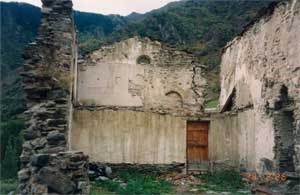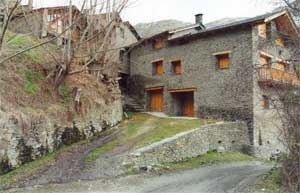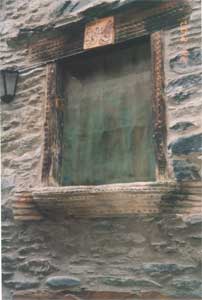
|
|
|
|
About Estaón
Estaón is the highest village in the Vall de Estaón at 1237m and is some 6Km from Ribera de Cardós (898m) up a winding sealed road.
Like all the villages around Vall de Cardos, Estaón developed over the
centuries as a subsistence farming village. Its inhabitants
 cultivated the land
by hand and with the aid of animals making enough produce to barely survive. The
people in the village used to bake their own bread in communal ovens and make
most
cultivated the land
by hand and with the aid of animals making enough produce to barely survive. The
people in the village used to bake their own bread in communal ovens and make
most
 of their winter clothing made out of wool from their sheep. Four fountains
which still there today, use to be the water supply for both people and animals.
of their winter clothing made out of wool from their sheep. Four fountains
which still there today, use to be the water supply for both people and animals.
Estaón first church of Sta Eulalia, only recently in ruins, was built in the IX century, Romanesque in style, Sta Eulalia boasted beautiful frescoes painted in the XII century, atributed to the Master of Pedret. These frescoes were removed from the church in the 1920's an now are permanently on display in The Museu D'art de Catalunya in Barcelona. Another section is in the Museum of Seu d'Urgell. The church still standing was built in the XVIII century dedicated to Sant Jaume, patron of the village, a new mural in the main altar was painted in 1966.
 Estaón had remained
virtually unchanged for hundreds of years until the 1960's when many young
people chose to trade subsistence farming for city life. Without exception all
villages around the area become virtually deserted. During the 80's and 90's
Estaón had remained
virtually unchanged for hundreds of years until the 1960's when many young
people chose to trade subsistence farming for city life. Without exception all
villages around the area become virtually deserted. During the 80's and 90's
 Estaón
has undergone a revival many houses in the village have been renovated by the
original owners with some barns and a few houses sold to city folk. Not
withstanding the renovations the village today remains very much the same as it
was in the past.
Estaón
has undergone a revival many houses in the village have been renovated by the
original owners with some barns and a few houses sold to city folk. Not
withstanding the renovations the village today remains very much the same as it
was in the past.
Accommodation in an apartment in a rural house Estaon Spain